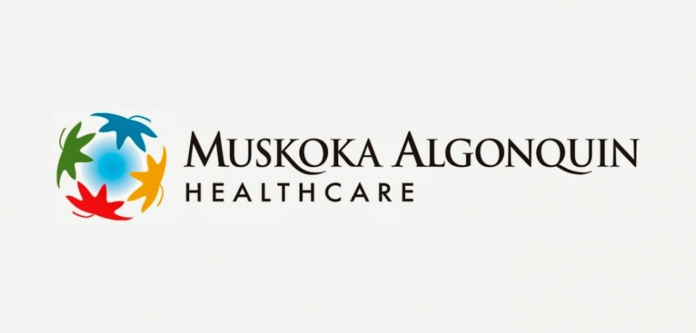Muskoka, May 1, 2024 – Muskoka Algonquin Healthcare (MAHC) outlines how the new health system plan will transform care for patients who no longer need intensive hospital treatment but still require ongoing care (known as Alternate Level of Care, or ALC). This initiative aims to improve health outcomes throughout the region.
The plan is part of the $1 billion investment from the province for two new hospitals in Muskoka and includes innovative strategies to better use resources and improve the delivery of care. A key focus is on enhancing care for ALC patients, ensuring they receive personalized support tailored to their unique needs.
Currently, many ALC patients occupy hospital beds designated for acute care, which is for patients needing immediate, intensive treatment. This situation has led to a misrepresentation of the actual need for acute care beds. For example, approximately 30-50% of acute care beds across both MAHC hospital sites are used by ALC patients, with additional patients soon to require similar care. The MAHC plan includes reorganizing hospital resources to align beds more accurately with patient needs, shifting ALC patients to more suitable care settings like specialized units for rehabilitation or to community services.
Cheryl Harrison, Chief Executive Officer at MAHC, stated, “Our goal is to ensure that ALC patients receive the right care, in the right place, at the right time. We’re redesigning how we care for these patients to optimize our resources and provide personalized care.”
Chuck Wertheimer, Senior Principal at Resource Planning Group (RPG), added, “Patients with ALC status, who can’t leave the hospital but don’t need acute care, take up beds that make it seem like we need more acute care capacity than we actually do. This shows the urgent need for more long-term care, home care, and community services, which hospitals in Ontario are struggling with.”
In line with the plan addressing the needs of ALC patients and those approaching ALC status, the proposed bed allocation at both sites is set to surpass the current demand for acute care beds. This excess capacity will provide important flexibility for future planning and adjustments. The plan also addresses the broader health system’s needs, including reducing wait times in the emergency department and adding a Level 3 Intensive Care Unit (ICU) to keep more complex medical cases local. It also complements provincial and community efforts to expand home and community-based care.
Moreover, new specialized units are being developed, such as a reactivation unit in Huntsville, equipped with essential amenities and staffed by multidisciplinary teams. These units are designed to help patients regain independence and transition smoothly to suitable care settings.
“We are dedicated to providing high-quality, patient-centered care that meets the evolving needs of our community,” Harrison emphasized. “By rethinking ALC care and creating specialized units, we aim to improve patient outcomes and enhance the overall healthcare experience.”
This comprehensive plan reflects MAHC’s commitment to improving healthcare delivery and ensuring the sustainability of health services in Muskoka.
More Information:
The proposed model for Muskoka Algonquin Healthcare (MAHC) Capital Redevelopment addresses the needs of the ALC population with foresight and compassion. Currently, up to half of the existing beds across both sites are occupied by ALC patients, with additional individuals at risk of becoming ALC patients. Recognizing the importance of balancing bed capacity, the provincial mandate for new hospitals stipulates a maximum of 20% for ALC patients.
In response to these challenges, the proposed model includes a vital reactivation unit at the Huntsville site. This unit is specifically designed to provide specialized care, enabling both ALC patients and those at risk of becoming ALC patients to maintain or improve their function and abilities. Hospitalization often poses a risk of functional decline, particularly for older patients, with studies indicating a significant decline in function after admission. Immobility during hospital stays can prolong recovery times and decrease the likelihood of returning home.
By prioritizing active and specialized care in the reactivation unit, MAHC aims to ensure that patients are prepared for discharge to their preferred destinations. Whether it be returning home or transitioning to a retirement home, the goal is to prevent physical decline to the point where these discharge options are no longer viable. This proactive approach, informed by the SF7 Toolkit v3 (2023) from the Regional Geriatric Program of Toronto, underscores MAHC’s commitment to promoting patient well-being and independence throughout their healthcare journey.
Requirements for a Hospital Reactivation Unit:
A Hospital Reactivation Unit is essential for patients transitioning from acute care, facilitating recovery, and preparing them for home or lower care levels. Key elements include a dining room for communal meals, access to a gym or rehabilitation staff for physical therapy, and activity spaces like TV lounges for recreation. Walking areas with rest spaces promote physical activity and rest, while a dedicated recreation coordinator ensures personalized engagement in rehabilitation activities. These types of features collectively support patients’ recovery, independence, and successful reintegration into their communities.
Why the Reactivation Unit is Designated to Huntsville:
Best practice suggests that patients have better outcomes when cared for in a specially designed unit with specialty staff focused on reactivation and rehabilitation. The synergy with the provincially designated stroke and rehabilitation beds makes Huntsville the most suitable location to provide the highest quality of care for these patients. Additionally, Level 3 ICU patients, requiring a longer stay, benefit significantly from a reactivation unit. These programs require the same resources, both staff and space, to care for all patients. Duplication of space or staff requirements would be impractical within both financial and human resource constraints.
Further Defining Alternate Level of Care (ALC):
Alternate Level of Care (ALC) denotes a scenario where a patient occupies an inpatient acute medical-surgical bed in a hospital but no longer necessitates the intensity of resources or services provided in this care setting. “Acute” in this context refers to the immediate and short-term medical attention typically delivered in a hospital setting. Essentially, ALC signifies that the patient has progressed beyond the acute phase of their illness or injury and requires a different level of care that better suits their current needs.
Seven Main Designations within ALC:
In the realm of Alternate Level of Care (ALC), patients are categorized into seven main designations, each tailored to their unique needs and circumstances. These designations provide direction to care providers on the next steps required in a patient’s care journey to ensure they are receiving the care best associated with their needs:
- Home and Home with Support: These patients require additional resources to facilitate their transition back home. Typically, services provided through the home care sector, such as Personal Support Worker (PSW), Nursing, or Rehabilitation services, are essential in ensuring a smooth transition.
- Palliative Care: For patients in need of medical or comfort care to support end-of-life planning, palliative care offers a compassionate approach. The focus here lies on enhancing quality of life measures, prioritizing comfort and dignity over acute medical interventions.
- Rehabilitation: Patients under this designation require specialized care aimed at maximizing their overall physical, sensory, intellectual, psychological, and social functions. Rehabilitation services are further subdivided into various types, including neuro, musculoskeletal, cardiac, geriatric, and others, tailored to individual needs.
- Complex Continuing Care (CCC) or Convalescent Care: This category caters to patients with complex medical needs that are not acute in nature. Specialized care is provided to address the unique challenges faced by these individuals, promoting their recovery and well-being.
- Mental Health: Patients requiring therapeutic services for addictions, psychological, behavioral, or emotional illnesses are provided with a designated bed for comprehensive mental health care. This approach emphasizes holistic treatment and support for mental well-being.
- Supervised/Assisted Living: For patients who can no longer reside independently in their own homes, supervised/assisted living facilities offer a supportive environment tailored to their specific needs and financial situation. Facilities like retirement and group homes ensure appropriate care and support while fostering independence and dignity.
- Long Term Care (LTC): Patients with chronic illnesses or disabilities requiring care beyond what is available in the community are provided with designated long-term care beds. Here, both medical and non-medical needs are met, ensuring comprehensive support for individuals with long-term care requirements.
Current Strategies Implemented to Assist ALC Patients:
- Behavioral Support Assistant (BSA): These specialists assist patients exhibiting behavioral issues related to their medical situation.
- Frailty Scale in Emergency Department: Early assessment of patients identifies high-risk individuals, allowing for timely intervention and appropriate care pathways.
- Hospital to Home Program (H2H): MAHC collaborates with the Muskoka and Area Ontario Health Team (MAOHT) and community partners to facilitate safe and early transitions home for ALC patients. This program has resulted in a notable 48% reduction in ALC patients transitioning to their homes rather than remaining in ALC status.
- Transitional Care Unit (TCU) with Hospice Muskoka: MAHC partners with Hospice Muskoka to provide specialized care for ALC patients in need of palliative care. This successful program has resulted in an 81% decrease in ALC transitioning to palliative care from the Bracebridge site.
- Seniors Assessment and Support Outreach (SASOT) Team: This community team in South Muskoka assesses, links, and refers eligible patients (65+) to services that enable them to remain at home.
Through active engagement with the Muskoka and Area Ontario Health Team (MAOHT), MAHC has established collaborative initiatives to support ALC patients and provide alternative care options beyond hospital settings. This ongoing partnership is vital for developing effective programs and services to meet the diverse healthcare needs of our communities.
Highlighting key programs aimed at reducing ALC at MAHC:
Remote Care Monitoring:
Our remote care monitoring program offers virtual daily checks for patients with conditions like Congestive Heart Failure (CHF), COPD, Diabetes, and COVID. Patients input vital signs daily, which are reviewed by local paramedics for early intervention, potentially reducing hospital visits.
Heart Function Clinic:
At our Bracebridge site, the Heart Function Clinic provides follow-up and education for patients with Congestive Heart Failure, ensuring personalized care for optimal heart health.
Surgical Transitions:
Our Surgical Transitions platform offers pre- and post-operative support for surgical patients, including daily assessments to address concerns and avoid unnecessary emergency department visits.
Mental Health Platform:
Our virtual Mental Health Platform allows patients to complete daily assessments monitored by mental health social workers for timely intervention and support.
Ocean eReferral Platform:
Our Ocean eReferral Platform streamlines referrals for diagnostics, specialists, and MAHC clinics, providing real-time updates and eliminating the need for faxed requisitions.
MyChart Patient Portal:
Our secure online MyChart Patient Portal offers personalized access to medical records, empowering patients to manage their health information conveniently.
Here are ways the community and public can show support:
Advocacy for New Programs and Services:
Advocate for the development of new programs, services, and facilities in Muskoka and surrounding areas to meet the needs of our aging population. Continued and sustainable funding is crucial to enhance the quality of care provided.
Advance Care Planning:
Consider advance care planning to ensure that individuals have a plan in place for managing their care if they are unable to do so at home. Discuss future care needs with loved ones and healthcare providers to create a comprehensive plan.
Join MAHC’s Patient, Family, and Caregiver (PFAC) Advisory Group:
Become a member of MAHC’s active advisory group to have a voice in shaping committees, programs, and initiatives. Your input as a community member is invaluable in ensuring patient-centered care. To learn more or apply to join PFAC: Patient and Family Advisory Council – Muskoka Algonquin Healthcare (mahc.ca)








